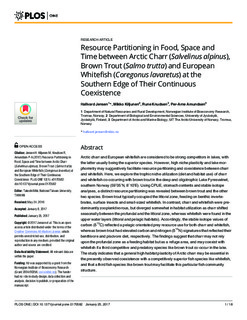| dc.contributor.author | Jensen, Hallvard | |
| dc.contributor.author | Kiljunen, Mikko | |
| dc.contributor.author | Knudsen, Rune | |
| dc.contributor.author | Amundsen, Per-Arne | |
| dc.date.accessioned | 2017-12-01T08:34:44Z | |
| dc.date.available | 2017-12-01T08:34:44Z | |
| dc.date.issued | 2017-01-25 | |
| dc.identifier.citation | Jensen H, Kiljunen M, Knudsen R, Amundsen P-A (2017) Resource Partitioning in Food, Space and Time between Arctic Charr (Salvelinus alpinus), Brown Trout (Salmo trutta) and European Whitefish (Coregonus lavaretus) at the Southern Edge of Their Continuous Coexistence. PLoS ONE 12(1): e0170582. | nb_NO |
| dc.identifier.issn | 1932-6203 | |
| dc.identifier.uri | http://hdl.handle.net/11250/2468691 | |
| dc.description.abstract | Arctic charr and European whitefish are considered to be strong competitors in lakes, with the latter usually being the superior species. However, high niche plasticity and lake morphometry may suggestively facilitate resource partitioning and coexistence between charr and whitefish. Here, we explore the trophic niche utilization (diet and habitat use) of charr and whitefish co-occurring with brown trout in the deep and oligotrophic Lake Fyresvatnet, southern Norway (59°05’N, 8°10’E). Using CPUE, stomach contents and stable isotope analyses, a distinct resource partitioning was revealed between brown trout and the other two species. Brown trout typically occupied the littoral zone, feeding on benthic invertebrates, surface insects and small-sized whitefish. In contrast, charr and whitefish were predominantly zooplanktivorous, but diverged somewhat in habitat utilization as charr shifted seasonally between the profundal and the littoral zone, whereas whitefish were found in the upper water layers (littoral and pelagic habitats). Accordingly, the stable isotope values of carbon (δ13C) reflected a pelagic orientated prey resource use for both charr and whitefish, whereas brown trout had elevated carbon and nitrogen (δ15N) signatures that reflected their benthivore and piscivore diet, respectively. The findings suggest that charr may not rely upon the profundal zone as a feeding habitat but as a refuge area, and may coexist with whitefish if a third competitive and predatory species like brown trout co-occur in the lake. The study indicates that a general high habitat plasticity of Arctic charr may be essential in the presently observed coexistence with a competitively superior fish species like whitefish, and that a third fish species like brown trout may facilitate this particular fish community structure. | nb_NO |
| dc.language.iso | eng | nb_NO |
| dc.publisher | Public Library of Science (PLoS) | nb_NO |
| dc.rights | Navngivelse 4.0 Internasjonal | * |
| dc.rights.uri | http://creativecommons.org/licenses/by/4.0/deed.no | * |
| dc.title | Resource Partitioning in Food, Space and Time between Arctic Charr (Salvelinus alpinus), Brown Trout (Salmo trutta) and European Whitefish (Coregonus lavaretus) at the Southern Edge of Their Continuous Coexistence | nb_NO |
| dc.type | Journal article | nb_NO |
| dc.type | Peer reviewed | nb_NO |
| dc.description.version | publishedVersion | nb_NO |
| dc.rights.holder | © 2017 Jensen et al. This is an open access article distributed under the terms of the Creative Commons Attribution License, which permits unrestricted use, distribution, and reproduction in any medium, provided the original author and source are credited. | nb_NO |
| dc.source.pagenumber | 18 | nb_NO |
| dc.source.volume | 12 | nb_NO |
| dc.source.journal | PLoS ONE | nb_NO |
| dc.source.issue | 1 | nb_NO |
| dc.identifier.doi | 10.1371/journal.pone.0170582 | |
| dc.identifier.cristin | 1473322 | |

